Amarok/QuickStartGuide/TheMusicCollection/pl: Difference between revisions
Neverendingo (talk | contribs) Importing a new version from external source |
Neverendingo (talk | contribs) Importing a new version from external source |
||
| Line 42: | Line 42: | ||
Klikając katalog domowy (z domkiem), pojawi się panel Źródła mediów, zawierający ikony do dostępnych miejsc. Klikając ikonę Pliki (druga ikona od dołu na zamieszonym poniżej, po lewej stronie zrzucie ekranu), dostrzec można coś podobnego do poniższego obrazka po prawej stronie. Zauważ jak rozszerza się Pasek położenia i jak prezentowana jest zawartość wybranego katalogu w Źródłach mediów. Po kliknięciu symbolu ''„>”'' można zobaczyć katalogi dostępne na tym samym poziomie struktury. Wbudowana przeglądarka plików w programie Amarok daje dostęp do całego systemu plików, czyli nawet do plików znajdujących się poza Lokalną kolekcją. | |||
{| class="tablecenter" border=1 | {| class="tablecenter" border=1 | ||
Revision as of 20:26, 30 September 2010
Kolekcja muzyczna
Źródła mediów
Źródła mediów służy do przeglądania i wyświetlania całej kolekcji muzycznej. Składa się ona z utworów na lokalnym dysku twardym, jak również tych umieszczonych na zewnętrznych urządzeniach i mediach podłączonych do komputera, jak płyta CD, klucz USB, odtwarzacze muzyczne, dyski sieciowe, czy źródła internetowe. Konfiguracja kolekcji
Posiadasz muzykę w formacie mp3, ogg czy FLAC na swoim komputerze? Wskaż programowi gdzie je znaleźć by stworzył kolekcję. W tym celu należy wybrać
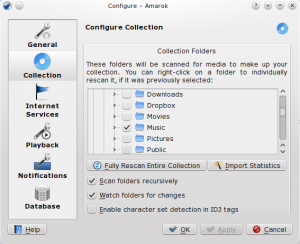
Widok drzewa katalogu Home przedstawiono na powyższym obrazku. Należy zaznaczyć gdzie znajduje się kolekcja. Zazwyczaj jest to katalog ~/Muzyka. Następnie trzeba kliknąć przycisk . Może to zająć trochę czasu, a program może by w tym czasie być zajęty. Po przeskanowaniu najlepiej uruchomić ponownie program. Nowa muzyka powinna pojawić się w sekcji Lokalna kolekcja.
Dodawanie urządzeń do kolekcji
Poniżej wyszukiwarki znajdującej się na górze Źródeł mediów, w Przeglądarce zawartości znajdują się różne urządzenia i/lub kategorie z zawartością. Podłączając płytę CD, pojawi się ona właśnie w Źródłach mediów. To samo dotyczy odtwarzaczy muzycznych i urządzeń USB, które pojawią się tam automatycznie po zamontowaniu urządzenia. Nie trzeba wykonywać żadnych dodatkowych czynności w tym celu.
Poniższy zrzut ekranu prezentuje trzy podłączone źródła z muzyką: płytę CD, odtwarzacz mp3 i Lokalną kolekcję.
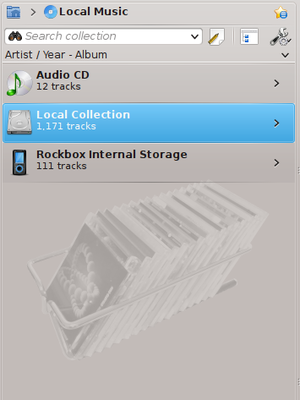
Zgrywanie płyty CD do kolekcji
Gdy użytkownik nie posiada żadnych plików muzycznych na swoim komputerze, może je zgrać (skopiować utwory z płyt audio CD do kolekcji). W tym celu należy kliknąć prawym przyciskiem myszy ikonę Płyta CD, która znajduje się w Przeglądarce zawartości by odtworzyć muzykę lub dodać ją do kolekcji, co zgra ją i oznakuje utwory (przykład niżej). Wybierając kopiowanie muzyki do kolekcji, na dole okna programu pojawi się pasek z informację o przebiegu operacji. Jeżeli zgrana muzyka nie pojawi się w przeglądarce zawartości, najlepiej ponownie uruchomić odtwarzacz Amarok. Poniższy zrzut ekranu prezentuje jak umieszcza się utwory z płyt CD, iPoda i innych urządzeń w lokalnej kolekcji używając menu kontekstowego.
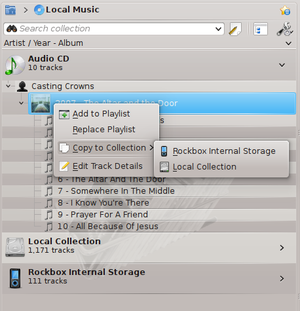
W powyższym przykładzie, w menu kontekstowym znajduje się również wpis . Jeżeli zachodzi potrzeba edycji znaczników utworu, można użyć tej opcji. Staje się to ważne przy zgrywaniu muzyki do formatu Wave, który pomija niektóre znaczniki. Do edycji znaczników większej liczby utworów, lepiej użyć dedykowanego do tego celu oprogramowania, takiego jak:
Poprawne oznakowanie jest ważne by Amarok poprawnie wyświetlał utwory w poprawnej kolejności i w odpowiednich albumach. Więcej na ten temat tutaj.
Dostęp do innych źródeł mediów
Możesz zastanawiać się dlaczego Źródła mediów nie są nazwane Kolekcją. Dlatego, że Amarok daje dostęp nie tylko do kolekcji, lecz także do sklepów internetowych, książek audio, podcastów, list odtwarzania i muzyki umieszczonej poza lokalną kolekcją. Pasek położenia programu jest kluczem do tego wszystkiego. Punktem początkowym Paska położenia, który znajduje się w lewym górnym narożniku Źródeł mediów, jest mały niebieski katalog z domkiem . Pasek rozszerza i zwęża się w zależności od nawigowania. Umożliwia on łatwą nawigację po kolekcji, klikając wybrany katalog w pasku.

Klikając katalog domowy (z domkiem), pojawi się panel Źródła mediów, zawierający ikony do dostępnych miejsc. Klikając ikonę Pliki (druga ikona od dołu na zamieszonym poniżej, po lewej stronie zrzucie ekranu), dostrzec można coś podobnego do poniższego obrazka po prawej stronie. Zauważ jak rozszerza się Pasek położenia i jak prezentowana jest zawartość wybranego katalogu w Źródłach mediów. Po kliknięciu symbolu „>” można zobaczyć katalogi dostępne na tym samym poziomie struktury. Wbudowana przeglądarka plików w programie Amarok daje dostęp do całego systemu plików, czyli nawet do plików znajdujących się poza Lokalną kolekcją.
| Media Sources pane | Files Icon clicked |
|---|---|
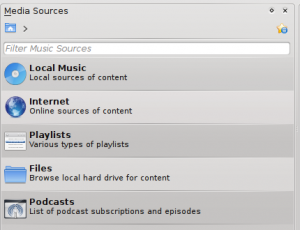 |
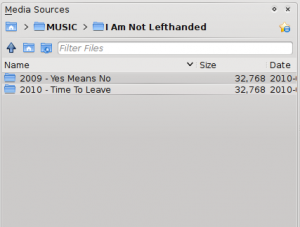 |
The functions of the icons in the Amarok Home folder (left above) are:
| Icon | Name | Action |
|---|---|---|
| Local Music | Your Amarok collection | |
| Internet | Internet shops such as Magnatune, Jamendo and Last.fm. First configure your internet resources in: | |
| Playlists | Saved playlists -- see alsoPlaylists. Also playlists on media devices | |
| Files | Your file system | |
| Podcasts | Access to Podcasts via RSS feed |
Clicking the Local Music icon above or on the Local Music folder in the Breadcrumbs bar returns you to your collection, showing you a list of all the available resources, artists, albums and tracks that you have previously defined as part of your collection. The Breadcrumbs bar indicates that you are viewing your Local Music.
Streams and Podcasts
There are two ways to listen to streams. If you have a favorite station, get the stream URL and add it: . You'll be able to find it again in Playlists, as a Saved Playlist. Otherwise, browse through the scripts available in our Script Manager (). There are some excellent collections available, which will show up in the Internet section of your Media pane.
Podcasts have their own section in the Media Pane, above. If you have an RSS or Atom feed URL, click the green and add it there. If you have an OPML file to import, that choice is available also. Use the context (right-click) menus to or mark an episode as New. If you are interested in browsing through a large collection of podcasts, check out the Podcast Directory available through the Script Manager, referred to above.
Using the Content Browser
The hard disk of your computer, audio CDs, external devices and the Internet are the basic resources for your collection. After your collection has been set up, it is likely that your collection will hold a large number of albums and tracks, much more than can be shown on a single window.
How to change the display of your collection, below:
Hiding or expanding information
The area of the Media Sources pane below the search bar is called the Content Browser. Three media sources are indicated in the image of a Content Browser below: CD, Local Collection and a Media Player:
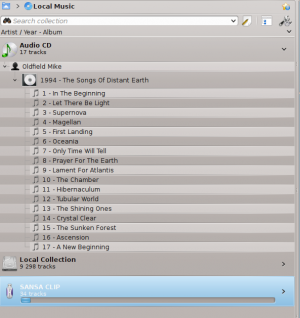
Clicking the banner for a device (the blue bar for the Sansa above) shows or hides the content of that device. The direction of the green arrow on the right indicates whether the contents for that device is hidden or shown. The content on a particular device can, in turn, be hidden or shown using the same principle, clicking on the appropriate artist or album. A - symbol on the left of an artist or an album indicates that the contents has been expanded. A + symbol indicates more contents for that category is available / currently hidden. In the image above, the information for Mike Oldfield - The Songs of Distant Earth CD has been expanded, showing the individual tracks. On the other hand, the albums and tracks in the Local Collection are hidden. By clicking these + or - symbols you also can expand or hide information.
Changing the order of tracks and albums
The order in which tracks are sorted in the Content Browser can be customised by using the Sort Options button at the top of the Media Sources pane:

The sort order is indicated on the top left of the Media Sources pane, just below the Search text box. The default order is Artist / Year - Album. The display order of the Content Browser can be temporarily switched between the user-defined sort order (described above) and a Merged view in which which artists are listed alphabetically, no matter on which media the music is stored. To toggle the Merged view,click the Merge icon at the top right-hand of the Media Sources pane:

To search your collection, type your search term into the search bar at the top of the Local Music section. Not only can you search by artist, album or track name, but any part. You might create a nice playlist by searching for winter, for instance, or merely find a track when you only remember one word of the title. You can also search by rating, playcount, even filetype. See Amarok Insider Issue 14 for more details.
Deleting items from the collection
You can delete any item from your collection by right-clicking on it and choosing the bottom item . A confirmation dialog will appear, preventing the accidental deletion of any tracks. More than one item can be selected with Ctrl+click.

